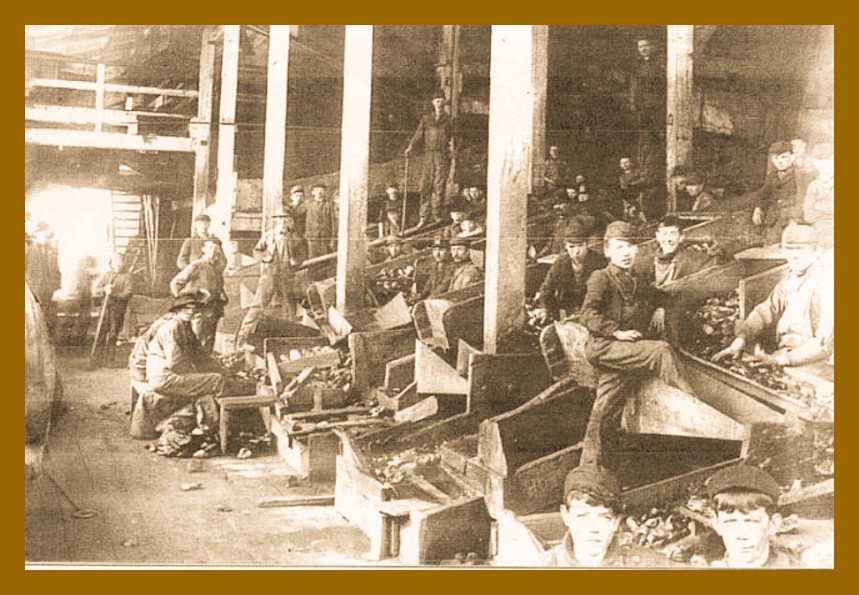Inside the Heckscherville Colliery breaker, 12 to 14-year-old boys pick rock and slate from the coal chutes. Several bosses stand by.
From a series of articles that appeared in the Pottsville Republican and Herald in 1997:
The Hecksherville Colliery, later the Anchor Colliery, was located in the Heckscherville Valley, north of the Thomaston Railroad Station.
The workings of this colliery were very extensive, embracing Payne’s water-level tunnel, two slopes and two tunnels below water level. The original opening was a slope sunk 260 feet on the Lelar Middle Split of the Mammoth Vein by E. Borda in 1852, from which gangways were driven 1,200 feet west and 1,500 feet east in about 1854.
In 1854, the colliery was operated by Richard Heckscher, Borda & Company, who sunk the Payne’s Shaft and extended the Payne’s Slope to a lower level. The shaft was 120 feet deep and was equipped with a powerful Cornish bull-pump designed to lift 326 gallons of water per stroke.
In 1859, Heckscher & Company sank a four-track slope to the first level on the Crosby Top Split of the Mammoth Vein 125 yards west of the slope ad drove a tunnel north from the foot of the slope to the Jugular Basin.
In 1864, the New York and Schuylkill Coal Company, with Charles Heckscher as president, took possession of the colliery, which operated until 1868, when it fell into the sheriff’s hands.
In 1867, the Jugular Basin, being exhausted, it was decided to construct a dam in the Jugular Tunnel to prevent water from the Jugular workings from draining into the lower workings of the Heckscherville Slope. The dam was 270 feet north of the Daniel Bottom Split of the Mammoth Vein gangway in the first lift tunnel from the Heckscherville Basin to the Jugular Basin.
In 1868, O’Donnel VonDerHyden & Company succeeded in the operation of the colliery, but only mined it until the great Heckscherville fire was discovered September 20, 1869.
In 1869, John Wadlinger began mining the third lift with the knowledge that the fire was still burning in the upper levels. Mining was continued until 1875.
In 1875, the Philadelphia & Reading Coal & Iron Company succeeded Wadlinger and continued mining the third level. But in 1877 the fire was drawn down to the lower workings and the mine was flooded and the colliery abandoned. The fire continued and in 1896, a rock slope was sunk to explore the old workings, and it found the fire was extinguished. However, in 1901, as a precautionary measure, the Dyer’s Creek was turned into the old workings and, in 1906, an examination of the rock slope showed no evidence of the fire.
The total shipment from the Hecksherville (Anchor) Colliery was 1,057,342 tons.
_______________________________________________
Article by Frank Blase, Historian, Reading Anthracite Company Historical Library, Pottsville Republican & Herald, March 29, 1997. Obtained from Newspapers.com.
Corrections and additional information should be added as comments to this post.

The rock tunnel is now exposed and there is a strip mining pit below it. Reading recently bought out the Mine Hill residents to try and go another level down to the virgin coal.
Hey Dave what can you tell me about the hole in the wall that’s up around near the potato patch?
And or the breaker that used to sit across from the school/ Cass township police headquarters building? Was always very interested in these places and often wondered who’d to ask for info? There’s not many old timers around anymore to find these things out. And these writings of all these places are great but do little in showing where they once stood